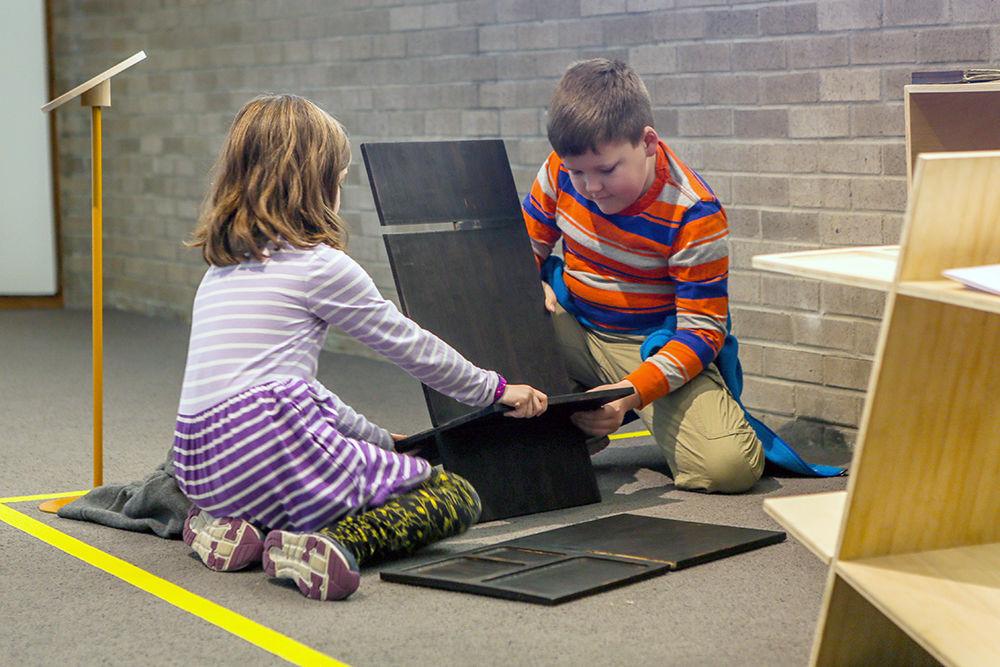
Nick Faulkner
Nine-year-old Hayden Kluttz and his seven-year-old sister Lexie Kluttz interact with the nomadic side table on Sunday in the North Carolina Museum of Art. The table was designed by Jason Swieckowski, a senior studying art and design. The ideal space exhibit, curated by the NC State College of Design, invites interaction with its pieces and runs through Jan. 25.
Ideal Space is an open and inviting exhibition created by an interdisciplinary group of students from NC State’s College of Design. The installation forces the audience to critically think about the furniture they use every day and is featured in the North Carolina Museum of Art through Jan. 25.
Will Reuther, a graduate student studying industrial design, was the one who envisioned the project and organized the event. He explained thatIdeal Space challenges people to reflect on the furniture and products used in their own lives.
“We want them to come to the exhibit, hangout, check out something new and hopefully gain a new perspective about products and furniture,” Reuther said. “We want people to leave the exhibit and rethink their furniture. Where were their things made, how much did they pay for them, were they worth it, do you even like them?”
This unique exhibit features pieces of furniture created by the students that show each designer’s interpretation of the theme “home.”
“We chose ‘home’ because it’s the most personal thing we can think of and something everyone can relate to,” Reuther said. “It’s something everyone has a very different perspective about and means something different to everybody. Also, home is a really personal space with the things you buy and the products you have. The furniture you have says something about you. You have those personal connections to those things. It’s your personal space.”
Visitors to the exhibit are encouraged to directly engage with the pieces physically by touching the work and intellectually by stopping and contemplating the work. Also, the designers want museum goers to provide feedback after they walk through the space.
“The more important aspect of the show is that it is interactive because it’s furniture and furniture is interactive,” Reuther said. “Usually you go to a museum and you’re not allowed to touch anything but we wanted the opposite. We want people to get really close and touch everything. This kind of reversed the roles of a regular exhibit.”
One of the designers, Raunak Mahtani, a graduate student studying industrial design, created clocks and worked with the concept of time. His pieces included an interactive component by encouraging viewers to stop and think about abstract concepts.
“There’s two time pieces that are conversation starters about time in general,” Mahtani said. “They are each based off a question about time. I wanted people to take an extra second to think about time as they’re viewing time. One is based off the question about whether time is definite or not and how definite it is. The other piece is based off the question, ‘is time the same each time?’”
The work of 10 design students are on display in the exhibit. These students were able to work on their independent pieces while still taking a full course load in the design school.
Monique Delange, the director of communications and marketing for the College of Design, explained the amount of work that students put into the project.
“I think what makes it, from an inside perspective, so interesting is that the design school is not easy,” Delange said. “The curriculum is very in depth and requires a lot of hours. For the students to then take on this self project, to me, is so incredibly over and above. I know the amount of work they put they put into it and the amount of sleepless nights they’ve had. I’m so impressed with all of them.”
It is also important to note that there was no outline or guidance to the project. The project was created from scratch in terms of the products, ideas and connections necessary to complete it.
“It was a huge learning experience for us,” Reuther said. “It was definitely an independent type of project where everybody had to hold themselves accountable. I tried my best to organize it but it was a self-sustaining group of students.”
Reuther’s ultimate goal was to get the exhibition in the North Carolina Museum of Art. He explained that when he reached out to the museum everyone was supportive and willing to help.
“Through getting this exhibition space at NCMA we got to work with the exhibition design team,” Reuther said. “It was really rad. It turned into this whole almost internship in the sense that we got to learn so much from them. They dropped so much knowledge on us about how people interact with things, how to help people understand exhibits and maneuver through spaces and understand visual cues and graphic elements.”
This free exhibit showcases the talent of the design students and encourages reflection about people’s products and personal spaces. Those interested in participating in the installation should head over to the North Carolina Museum of Art or find more information on the NCMA website.